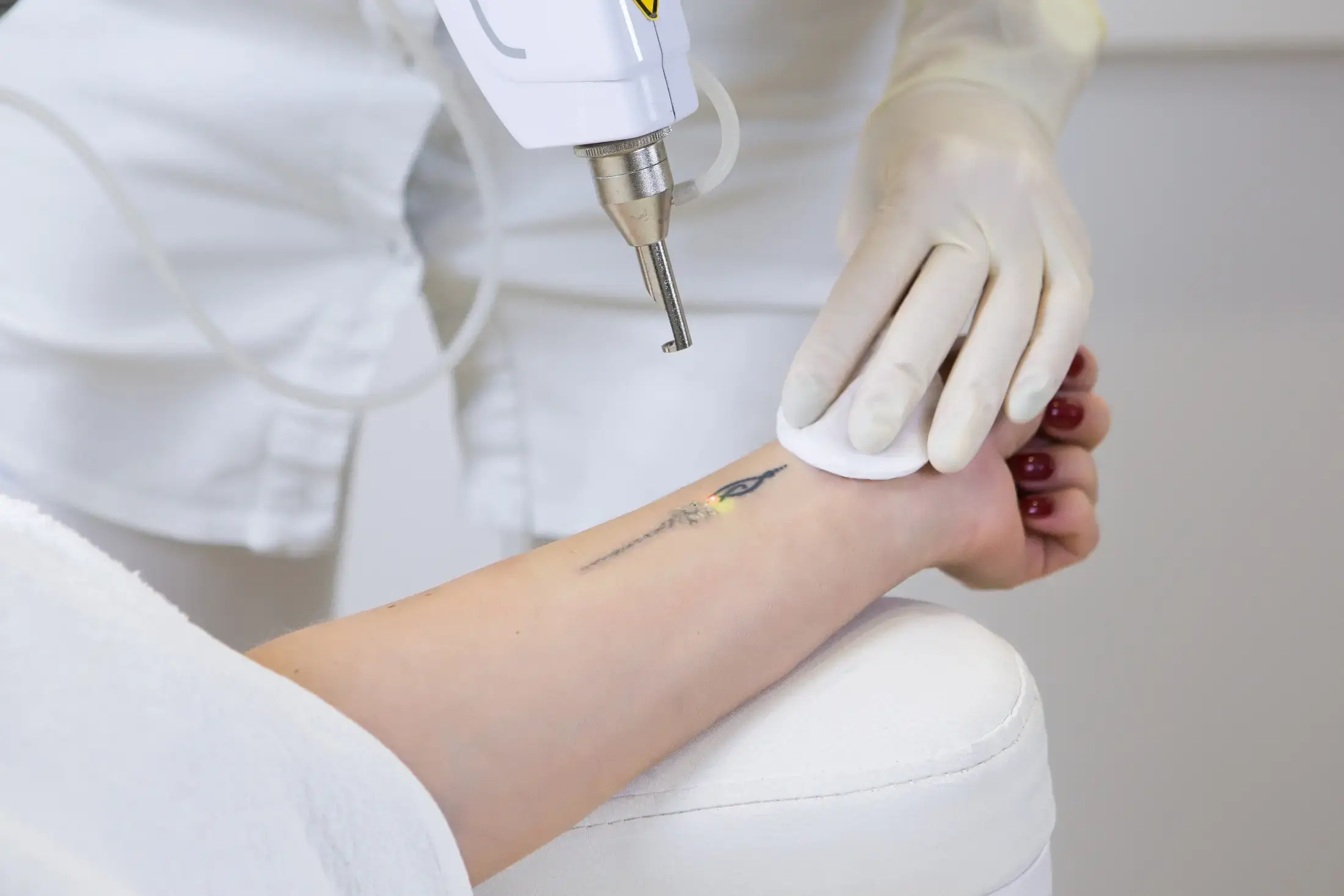
Tattoos are often a meaningful form of self-expression, but for some, they become an unwanted reminder of the past. Laser tattoo removal is the safest and most effective way to remove unwanted ink, providing better results with fewer risks than alternative methods like dermabrasion or excision.
However, many people considering laser tattoo removal have concerns about safety, side effects, and potential risks. Does tattoo removal hurt? Does it leave scars? Can it cause long-term damage to the skin? Understanding the procedure, who it is safe for, and what to expect is crucial before committing to treatment.
In this guide, we’ll answer the most common laser tattoo removal safety questions and discuss:
- Who should and shouldn’t get laser tattoo removal (including pregnant and breastfeeding individuals)
- Potential side effects and how to minimize risks like scarring or skin discoloration.
- What happens to the skin after tattoo removal and how to ensure the best results.
If you’re considering tattoo removal, knowing what to expect will help you make an informed decision about whether it’s the right choice for you.
Is Laser Tattoo Removal Safe?
Yes, laser tattoo removal is an FDA-approved procedure and is considered safe when performed by trained professionals. The specialized laser technology used in medical settings is designed to target tattoo ink while minimizing damage to the surrounding skin.
However, not everyone is a good candidate for laser tattoo removal. Certain health conditions, medications, and skin sensitivities can increase the risk of side effects, making it important to consult a professional before beginning treatment.
Who Should NOT Get Laser Tattoo Removal?
While laser tattoo removal is generally safe, it may not be recommended for:
Individuals who are pregnant or breastfeeding
- Is laser tattoo removal safe during pregnancy? No, it is not recommended.
- The body’s immune response and skin sensitivity change during pregnancy, and there is limited research on how laser treatments affect pregnant or breastfeeding individuals.
- To ensure safety, it’s best to wait until after pregnancy and breastfeeding before undergoing tattoo removal.
People with Certain Skin Conditions or a History of Keloid Scarring
- Individuals with eczema, psoriasis, or vitiligo in the treatment area may experience flare-ups, irritation, or pigmentation changes.
- Those with a history of keloid scarring are at a higher risk of developing scars after laser treatment.
Anyone with Active Skin Infections or Open Wounds
- If you have a rash, infection, or sunburn in the area to be treated, laser removal should be postponed until the skin has fully healed.
Those Taking Photosensitizing Medications
- Certain medications, such as antibiotics, acne treatments (like Accutane), or other prescriptions that increase light sensitivity, can make the skin more prone to burns, hyperpigmentation, or irritation.
For most people, laser tattoo removal is a safe and effective procedure when performed correctly. Choosing a qualified provider and following proper aftercare instructions will help minimize risks and improve results.
Understanding the Side Effects & Risks of Laser Tattoo Removal
While laser tattoo removal is considered safe when performed by professionals, it’s important to understand potential temporary side effects and long-term risks before starting treatment.
Temporary Side Effects
Most side effects are mild and short-term, with skin typically healing within a few weeks. These may include:
- Redness & swelling – The treated area may appear irritated, similar to a sunburn.
- Blistering & scabbing – Some patients experience small blisters or scabs, which are part of the normal healing process.
- Itching & dryness – As the skin regenerates, mild itching or flaking can occur.
Tattoo Removal Tip – How to reduce discomfort: Keeping the area moisturized and avoiding picking at blisters or scabs can speed up healing.
Long-Term Risks (Rare but Possible)
Although uncommon, some individuals may experience lasting skin changes:
- Hyperpigmentation (dark spots) – More common in individuals with darker skin tones or those who don’t follow aftercare instructions.
- Hypopigmentation (light spots) – The treated area may appear lighter than the surrounding skin, especially if the laser is too aggressive.
- Scarring – Rare, but can occur if aftercare is not followed properly or if a patient has a history of keloid scarring.
Although laser tattoo removal has some potential side effects, they’re typically mild and can be easily minimized with proper technique and aftercare.
Can Laser Tattoo Removal Cause Cancer?
One of the most common concerns about laser tattoo removal is whether it increases cancer risk. The short answer? No, laser tattoo removal does not cause cancer.
Debunking the Myth
- There is no scientific evidence linking laser tattoo removal to cancer.
- Lasers target ink, not DNA – The laser works by shattering ink particles, which are then naturally eliminated by the body.
- It does not penetrate deep enough to affect organs or cause cellular mutations.
Why the Concern?
- Some worry about the breakdown of ink particles, but there is no proof that this process increases cancer risk.
- The FDA approves laser tattoo removal as a safe cosmetic procedure when performed by licensed professionals.
How to Ensure Safe Treatment
- Choose a reputable provider with FDA-approved technology.
- Avoid unregulated tattoo removal methods or at-home treatments.
- Monitor skin health and consult a dermatologist if concerned.
Ensuring Safe Tattoo Removal
Laser tattoo removal is a highly effective and safe procedure when performed correctly, but taking the right steps can help minimize risks and improve results. To ensure the safest experience:
- Choose a reputable provider with FDA-approved technology to reduce the risk of complications.
- Avoid unregulated tattoo removal methods or at-home treatments, which can cause scarring or skin damage.
- Follow all aftercare instructions carefully to support proper healing and prevent irritation.
- Monitor your skin health and consult a professional if you have concerns about healing or pigmentation changes.
Safe & Professional Laser Tattoo Removal at Gulf Coast Facial Plastics
At Gulf Coast Facial Plastics, safety is at the core of everything we do. Our laser technician, Jessica Daube, MSN, FNP-C, is a highly qualified nurse practitioner with extensive laser experience. She works closely with every patient to evaluate candidacy, set realistic expectations, and ensure the best possible results. If laser tattoo removal isn’t the right choice for you, she’ll let you know—so you never have to worry about undergoing treatment that isn’t safe for your skin.
Learn more about Jessica Daube’s background and expertise here: Jessica Daube, MSN, FNP-C
If you’re considering tattoo removal, our team is here to help you make an informed decision. Schedule a consultation today and take the next step toward clear, ink-free skin.
Frequently Asked Questions
Is laser tattoo removal safe for all skin types?
Laser tattoo removal is safe for many skin types, but darker skin tones may have a higher risk of pigmentation changes like hyperpigmentation (dark spots) or hypopigmentation (light spots). This is because the laser targets pigment, and skin with more melanin can sometimes react differently.
At Gulf Coast Facial Plastics, our laser technician, Jessica Daube, MSN, FNP-C, carefully evaluates each patient’s skin type and medical history to determine whether laser tattoo removal is the right option. If you’re considering treatment, scheduling a consultation is the best way to receive personalized guidance based on your unique skin and tattoo characteristics.
Can laser tattoo removal damage my skin permanently?
Permanent damage is very rare when laser tattoo removal is performed by a skilled professional. In some cases, patients may experience scarring or pigmentation changes, but these are uncommon when proper aftercare is followed. The treated area may temporarily appear lighter or darker, but this often resolves over time. Choosing an experienced provider and following all post-treatment instructions carefully will help prevent complications and support proper healing.
What should I do if I experience side effects?
Mild side effects like redness, swelling, blistering, or scabbing are normal and usually fade within a few weeks. Keeping the area clean and dry, avoiding picking at scabs, limiting sun exposure, and following aftercare instructions will help speed up healing and reduce irritation. If side effects persist or worsen, it’s best to contact your provider for guidance.
Are there safer alternatives to laser tattoo removal?
While other tattoo removal methods exist, laser removal is the safest and most effective option when performed by a professional. Tattoo removal creams are often ineffective and can cause skin irritation. Dermabrasion, which sands down the skin, can be painful and increases the risk of scarring. Surgical excision, where the tattooed skin is cut out and stitched, works for very small tattoos but leaves a scar. For most people, laser tattoo removal provides the best balance of safety and results, especially with proper aftercare.

 (850) 784-7722
(850) 784-7722




